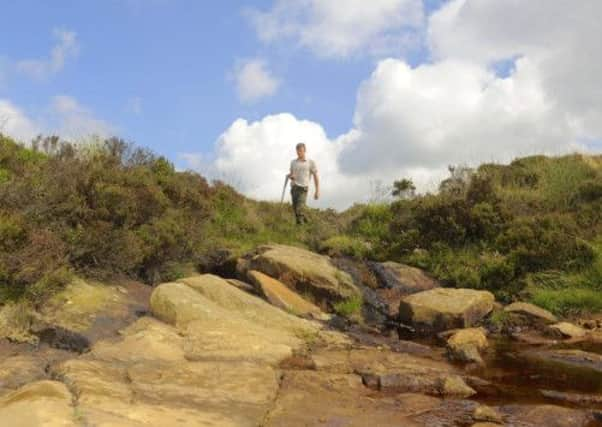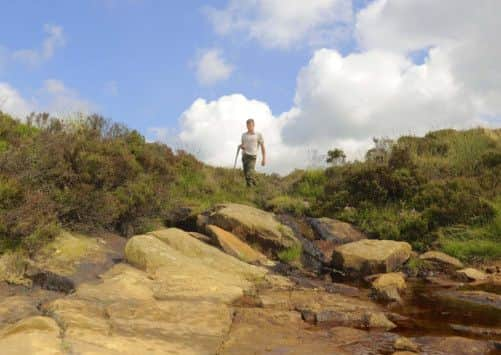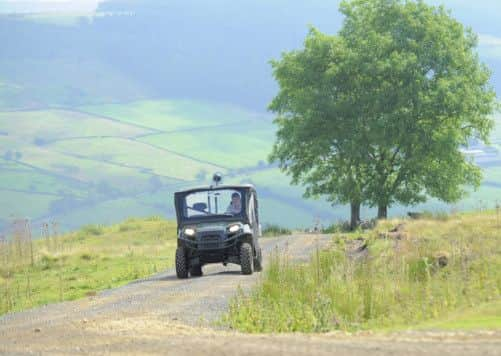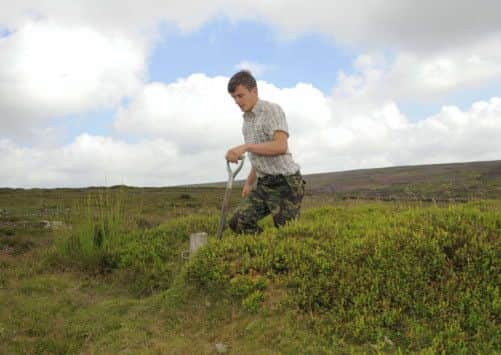Glorious Twelfth video: The game changer


Anthony Orr is on top of the world just now, as any clean-cut, good-looking 19 year-old has every right to be. In addition to his natural advantages, Anthony also has the satisfaction of being judged the best in the business that he is in, the top young man in the country in fact.
Anthony was recently voted by the National Gamekeepers Organisation as Gamekeeping Student of the Year. This was after completing a Level 2 apprenticeship in game and wildlife management at Askham Bryan College in York. He did his studying while being employed as under keeper on the 7,000 acre Spaunton estate in North Yorkshire.
Advertisement
Hide AdAdvertisement
Hide AdFor now however, all his thoughts of the pleasure of winning are put behind him as he focuses on another date, the biggest of the year, which falls on Monday. August 12 marks the start of the new grouse shooting season and maintaining this landscape in the pomp and magnificence which millions of visitors now expect requires big money.


What about public subsidies to cultivate this land? That was yesterday’s idea which failed. After the war, heavy grazing pressure was put on the heather moorlands, commercial forests were planted and the high peat bogs were drained by digging ill thought-out channels which speeded the flow of water into the rivers and contributed the flooding of towns and cities downstream.
It took half a century for these mistakes to be reversed and for the heather moorlands to be re-evaluated in a brave new green world of conservation as complex eco systems whose fragility required thoughtful handling.
The 800,000 acres which survived in the British Isles are unique. Almost three-quarters of them now bear the European Union’s highest conservation designation of Special Protection Area. Three quarters of them are Sites of Special Scientific Interest.
Advertisement
Hide AdAdvertisement
Hide AdThese days it’s grouse – and the revenue to be recouped from shooting the surpluses of local populations – which are the future for heather moorlands.


This helps pays for the £52.5m ploughed into the annual conservation management of the 150 English moors. One shooting party might bring £200,000 into one part of Ryedale in a week’s sport.
The money trickles down into the local economy through the pockets of the hoteliers, garage and shop owners and the many locals who turn up to help at the shoots.
So when August 12 dawns, the gamekeepers have to be able to deliver their side of the deal. That seems quite a burden of expectation to hang around the neck of a teenager.
Advertisement
Hide AdAdvertisement
Hide AdBut when we meet on his bracing patch under grey morning skies which quickly turns to sunshine, Anthony does not look in the least like someone weighed down with worry.


His current home is a tied cottage almost on top of the moor. His view must be one of the most spectacular in Yorkshire.
Outside is the transport of choice for today’s gamekeeper, a Polaris Ranger, an all-terrain vehicle made by the American company which also invented the snowmobile. Inside are the gamekeepers’ traditional accoutrements, four dogs (two Labradors, a Springer and a Patterdale terrier) and a shotgun. Otherwise it’s probably a typical bachelor pad. “Good in the summer time,” he says. “Dark nights in the winter…”
Nightlife, in the shape of two village pubs, is almost next door as the crow flies, but in reality it means flogging up and down a twisty, precipitous slope to enjoy a night out.
Advertisement
Hide AdAdvertisement
Hide AdAnthony plays on the pub pool team and a red and white Middlesbrough FC football at the top of the stairs suggests game shooting is not the only sport in his life. Nor is he a countryman by birth, having grown up in the Middlesbrough suburb of Ormesby.
His day begins at 7.15 when he sees to the dogs and the Polaris, has breakfast and then sets off. What are his daily tasks? There’s a pause while he wonders where to start. It turns out that only by spending a few hours out on the moors in his company do you come to appreciate how many there are.
The Polaris makes a racket as it lurches down gullies and surges over heather, the balloon-like tyres keeping the show on the road on the most improbable gradients. What did gamekeepers do before they had these? “Wellies”.
Our companion today, George Thompson, knows all the answers because he has been doing this job for 23 years.
Advertisement
Hide AdAdvertisement
Hide AdHe is the head keeper on the Spaunton estate and is travelling with us to make sure I get the facts straight. Seven thousand acres seems like an awfully big territory, but George, another one from Middlesbrough, seems to have intimate knowledge of every inch of it.
He spent his first 17 years of his working life in the construction trade. Then his lifetime passion for the beauty of what lay beyond the town’s smoking chimneys led George to switch careers.
For Anthony, it was his father Craig who led their family’s urban exodus. He became a gamekeeper in Kildale and Anthony’s uncle Andrew became a gamekeeper at Egton Bridge where Anthony got his first taste of the work.
His younger brother Connor is just starting as a trainee.
They embody the connection between an unlovely town created by heavy industry and its gorgeous hinterland. It was the ironstone mined and smelted on these ravishing moors which made Middlesbrough great.
Advertisement
Hide AdAdvertisement
Hide AdAnthony’s home is one of what was originally a row of 16 miners’ cottages built in the 1880s. The fairly recent approach road (built by the gamekeepers – another of their tasks) was laid over the railway track which carried the pig iron to Teesside.
Today happy holidaying families stroll along the dirt road from their parked campervans, past attractive green contours, unrecognisable as the once ugly slag heaps and detritus of the smelters.
Anthony says in that the run-up to this new season they have to complete eight weeks’ work in three. The three major jobs are getting the butts ready, bracken spraying and grit. Grouse need water, heather and grit to live. The grit is to help digest their food and it is given a medicated coating to protect them from a worm which eats into their gut.
The grit supplies must be switched to non-medicated in time for a 28-day withdrawal period before the shooting season and the bird meat enters the human food chain.
Advertisement
Hide AdAdvertisement
Hide AdThis morning we stop the Polaris at some of the 4,000 grit stations to double check the contents have been changed. The grit trays are laid out as a grid to cover the whole moor. Each grid square measures about 100 by 150 yards: grouse are very territorial birds, or at least the males are, and that is about as far as they are likely to stray even though they are completely wild.
Unlike the situation with some other game birds like pheasant, what you have is what you’ve got. You can’t buy in a bunch of extra grouse from dealers to pad things out for a shooting day.
Maintaining the size of a grouse population and then adding a surplus that can be shot calls for all the skill and experience you can muster.
Many things impinge on a grouse’s wellbeing that are outside human control, like the weather.
Advertisement
Hide AdAdvertisement
Hide AdAt breeding time, a mother hen should be as fat as butter and able to cover 10 eggs. But the bitter east wind that persisted for weeks this spring wreaked havoc with the heather which is both food and shelter for the grouse.
“Unlike the Pennine moors, we had no snow to protect the heather,” adds Anthony. “We have never known the North York Moors turn ginger before.”
That setback is the main reason why George reckons this “will not be a bumper year” for grouse numbers.
Annoying weather apart, the trick of game moor management is to seek a balance so that plenitude results. It means seeing off predators like stoats, weasels, mink and foxes on the ground and jackdaws and carrion crows in the air. Success, according to Anthony, “is about having a lot of everything”.
Advertisement
Hide AdAdvertisement
Hide AdSome years ago an experiment was tried where all gamekeeper management was withdrawn from a Scottish moor. Disaster followed – for grouse, the protected raptors, the ground-nesting birds, wildlife habitat, the lot. The bird-watching lobby often presents itself as antithetical to game shooting interests. This, and the class division it seems to typify, exasperates George. He points out he’s not posh but he loves shooting and so do many others who do not come from the ranks of the rich. And he has an enthusiasm for birds of prey – falconry is one of his pastimes.
It is illegal to reduce numbers without a licence from Natural England but if a hawk puts in an appearance in the sky at the wrong moment the panic it brings can destroy months of preparation.
“When you are getting ready for the shoot day and one big bird of prey flies through the middle of that, it’s like the riot squad coming through your moor,” says George.
Heather moorlands, it seems are prone to the law of unintended consequences. There were sufficient merlin around here to bring an academic study group into being. A triumph it seems for the policy of giving birds of prey legal protection.
But Anthony says he has not found a merlin nest this year.
Advertisement
Hide AdAdvertisement
Hide AdOn the other hand, a larger bird of prey, the buzzard, has multiplied. Could the rise of the larger raptor be connected to the disappearance of the other? George notes that 20 years ago there were no buzzards on the North York Moors. “Now you see a buzzard every day.”
There are 17 “drives” on Spaunton Moor and usually 10 of the 17 are good to shoot. When the beaters drive the grouse through the heather they fly up towards the butts at something like 80 mph. The shooters will pay about £160 for a brace plus VAT and will shoot 80 to 100 brace a day. A drive takes three quarters of an hour and there are usually three in the morning and two in the afternoon. It’s not unusual for the members of shooting parties to sign the cheque for next year’s visit when the present one concludes. Or it may be that one of them is laying it on as a gift for friends.
As the Polaris rattles its way back to Anthony’s cottage, we observe the passing scene and Anthony and George tick off the things to do that require a game keeper to be a real jack-of-all trades: predator control, heather burning, control of bracken, maintaining roads, paths, walls and water courses, tick control and general maintenance of this lovely landscape.
The long list doesn’t daunt Anthony in the slightest. He is ambitious to be a head keeper and run his own moor one day. “It’s not a job,” he smiles. “It’s a way of life.”